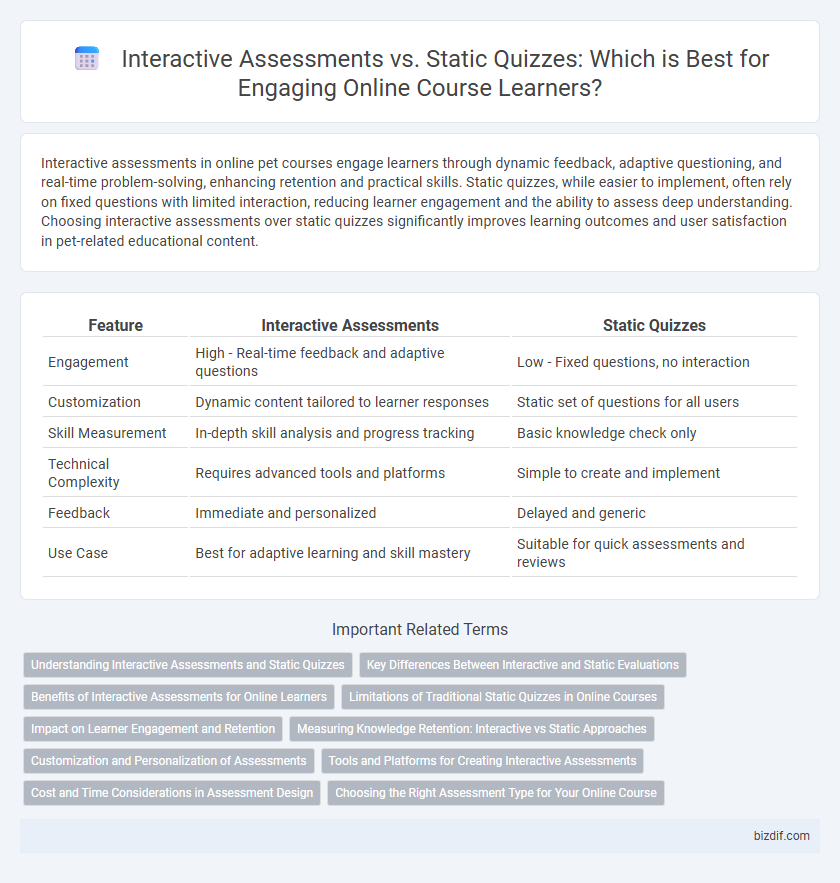Interactive assessments in online pet courses engage learners through dynamic feedback, adaptive questioning, and real-time problem-solving, enhancing retention and practical skills. Static quizzes, while easier to implement, often rely on fixed questions with limited interaction, reducing learner engagement and the ability to assess deep understanding. Choosing interactive assessments over static quizzes significantly improves learning outcomes and user satisfaction in pet-related educational content.
Table of Comparison
| Feature | Interactive Assessments | Static Quizzes |
|---|---|---|
| Engagement | High - Real-time feedback and adaptive questions | Low - Fixed questions, no interaction |
| Customization | Dynamic content tailored to learner responses | Static set of questions for all users |
| Skill Measurement | In-depth skill analysis and progress tracking | Basic knowledge check only |
| Technical Complexity | Requires advanced tools and platforms | Simple to create and implement |
| Feedback | Immediate and personalized | Delayed and generic |
| Use Case | Best for adaptive learning and skill mastery | Suitable for quick assessments and reviews |
Understanding Interactive Assessments and Static Quizzes
Interactive assessments engage learners through dynamic question types like drag-and-drop, simulations, and real-time feedback, enhancing comprehension and retention. Static quizzes typically consist of fixed multiple-choice or true/false questions, offering limited learner interaction and immediate scoring without adaptability. Incorporating interactive assessments in online courses fosters deeper understanding by encouraging active participation and critical thinking.
Key Differences Between Interactive and Static Evaluations
Interactive assessments use dynamic question formats like drag-and-drop, simulations, and real-time feedback to enhance learner engagement and retention, while static quizzes rely on fixed multiple-choice or true/false questions with limited learner interaction. Interactive evaluations adapt to user responses, providing personalized learning paths, whereas static quizzes offer uniform assessments regardless of individual performance. The key difference lies in the level of engagement and adaptability, with interactive assessments driving deeper learner involvement and more effective skill measurement.
Benefits of Interactive Assessments for Online Learners
Interactive assessments boost engagement by incorporating real-time feedback, adaptive questioning, and multimedia elements that cater to diverse learning styles. These dynamic tools enhance knowledge retention and critical thinking skills through active participation and personalized learning paths. Compared to static quizzes, interactive assessments provide deeper insights into learner progress, facilitating more effective remediation and targeted support.
Limitations of Traditional Static Quizzes in Online Courses
Traditional static quizzes often fail to engage learners effectively due to their fixed question formats and lack of adaptive feedback, limiting knowledge retention and personalization. These quizzes typically do not accommodate diverse learning styles or adjust difficulty levels based on individual performance, resulting in reduced motivation and suboptimal learning outcomes. Incorporating interactive assessments enhances learner engagement by providing real-time feedback, varied question types, and adaptive challenges tailored to individual progress.
Impact on Learner Engagement and Retention
Interactive assessments significantly boost learner engagement and knowledge retention by promoting active participation and immediate feedback, unlike static quizzes which often lead to passive learning and lower motivation. Features such as drag-and-drop activities, scenario-based questions, and real-time scoring encourage critical thinking and reinforce concepts more effectively. Research from eLearning Industry indicates courses with interactive elements see a 60% higher completion rate and 40% improvement in knowledge retention compared to those with static assessments.
Measuring Knowledge Retention: Interactive vs Static Approaches
Interactive assessments enhance knowledge retention by engaging learners with real-time feedback, adaptive questioning, and scenario-based exercises that promote critical thinking. Static quizzes often rely on memorization and multiple-choice questions, which may not effectively measure deep understanding or long-term retention. Incorporating interactive elements leads to improved learner motivation and more accurate evaluation of knowledge retention over time.
Customization and Personalization of Assessments
Interactive assessments offer dynamic customization options, enabling instructors to tailor question types, difficulty levels, and feedback based on individual learner progress. Unlike static quizzes, these assessments adapt in real-time, providing personalized learning experiences that enhance engagement and knowledge retention. Advanced platforms support branching scenarios and adaptive questioning, optimizing assessment relevance and effectiveness for diverse learner needs.
Tools and Platforms for Creating Interactive Assessments
Platforms such as Articulate 360, Adobe Captivate, and H5P offer robust tools for creating interactive assessments that enhance learner engagement through drag-and-drop activities, simulations, and real-time feedback. Unlike static quizzes, these tools enable adaptive testing paths and multimedia integration, improving assessment effectiveness and learner retention. LMS integrations with Moodle, Blackboard, and Canvas further streamline deployment and data tracking for interactive content.
Cost and Time Considerations in Assessment Design
Interactive assessments require more development time and higher upfront costs due to the need for dynamic content, adaptive feedback, and complex question types, whereas static quizzes are quicker and cheaper to produce with fixed questions and immediate grading. Investing in interactive assessments can lead to improved learner engagement and better knowledge retention, potentially reducing the need for follow-up courses or remediation. Organizations often balance their budget by strategically incorporating both formats, leveraging static quizzes for foundational checks and interactive assessments for critical evaluations.
Choosing the Right Assessment Type for Your Online Course
Interactive assessments boost learner engagement and provide real-time feedback, enhancing knowledge retention through dynamic question formats like simulations and drag-and-drop tasks. Static quizzes, featuring fixed question sets and straightforward formats, are effective for quick evaluations and course checkpoints with minimal technical requirements. Selecting the right assessment depends on course objectives, learner preferences, and the desired level of interaction to maximize educational outcomes.
Interactive assessments vs Static quizzes Infographic

 bizdif.com
bizdif.com